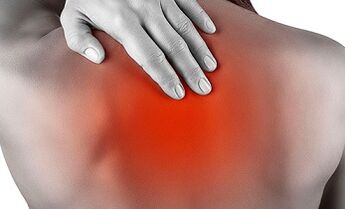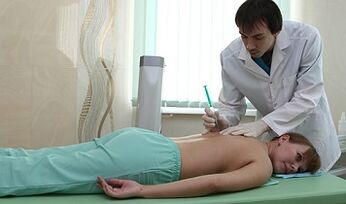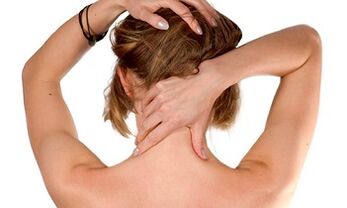Cervical osteochondrosis is a disease that is difficult to diagnose when the patient's initial treatment of the doctor has been slowed down due to many signs and the disease has slowed down.
The development and manifestation of pathology
The osteochondrosis of the cervical spine is found in people who lead a sedentary lifestyle and do sedentary work.
Signs

Signs of osteochondrosis of the cervical vertebrae are not only in the cervical region and in the upper shoulder zone, but also headache and chest pain.
Many syndromes can be distinguished, each characterized by their own signs.
Cock syndrome is the cause of nerve endings in the intervertebral space of cervix spaces.Typical features:
- pain in the cervical region;
- pain in the forearm and hands;
- Feelings of tingling, numbness in the forearm.
Cardial syndrome (or heart syndrome) is due to a violation or irritation of the root of the membrane nerves and large chest muscle.In this case, the signals are served as pain in the heart area, which will be sharp and sharp when the head rotation, sneezing or other neck movement (such as angina pectoris).
Vail artery syndrome.Signs of osteochondrosis in this case:
- Pulsating headaches for the occlital, frontal (above the eyebrow) and in the temporal part that are constant;
- The hearing aid, the vestibular device, the disorders of the vision (if the cervical chips are already neglected) are possible.
Irrititive Reflex syndrome.Signs of such a syndrome are as follows:
- Pulsating pains in the occlital part of the head;
- pain in the cervix, even towards the chest or to the side, in the shoulder joint;
- Strengthening pain after sleep, sharp movement of the head (including sneezing, coughing).
Symptoms
Developing osteochondrosis symptoms depend on which nerve root is damaged.In the 7th cervix, the vertebrae, between which are nerves.Their harmful pain causes pain in the development of osteochondrosis.

The vertebrae are viewed from above and the Roman numbers (CI, CII) indicate.The nerve endings between them are similarly considered and are indicated by Arabic numbers (C1, C2).The letter C denotes a class of cervix (the cervix).
- When damaging the end of the first and second vertebrae (C2), the main symptom is the loss of numbness and sensitivity in the occlital part.Later - pain there.
- The damage between the second and third vertebrae (C3) leads to sensitivity to the area and later leads to sensitivity and impaired tongue (speech damage).
- Damage to the nervous end of the third and fourth vertebrae (C4).In this case, the pain is concentrated in the wrist, passes through the heart area, and it is possible to have breathing damage.However, the pains are preceded by a feeling of numbness of the collar and shoulders.
- Damage to the C5 nerve root between the fourth and fifth vertebrae.In the case of damage, it responds by damage to the sensitivity of the limbs, both in the upper and lower and the pain in the forearm and in the outside of the shoulder.
- The nervous ending is the damage to the fifth, sixth and seventh vertebrae (the most common cervix -osochondrosis).Symptoms of pinching the nerve endings of the C6 and C7 are periodic numbness of fingers and hands, cervical pain, forearm and bottom - the sheet, back, to the groin.
- Damage to the C8 nerve.The pain is concentrated on the neck and spreads through the forearm to the elbow and the lower limbs.The pain was preceded by the loss of sensitivity in the hands of the hands (fingers, brushes), feet (fingers, legs), and in significant areas of the skin.In the limbs, blood circulation is disturbed, which affects the color of the skin and feet.
Reasons

Cervical osteochondrosis is increasingly found in the young population.Explaining the occurrence of the disease is more often due to poor lifestyle than hereditary predisposition.
Of the hereditary causes, not only the genetic predisposition of the disease is distinguished, but also the presence of chronic diseases and the hereditary disorders of the formation of the spine.
The causes of osteochondrosis of the cervical vertebrae associated with the cervical vertebrae are very wide.They belong to:
- Inadequate nutrition, and consequently excess body weight, body disturbed metabolism, lack of vitamins and minerals.
- A sedentary lifestyle caused by session or uniform work.Unstable physical activity.
- Severe physical activity.This includes professional sports and frequent lifting of weights.
- The curvature of the spine, the violation of posture, the consequences of spinal injuries, and flat legs were formed.
- Stress, frequent nervous strain.
Diagnosis
Diagnosis of osteochondrosis should only be made by a doctor.
Visual diagnosis
When contacting a neurologist and an orthopedic doctor, the patient is initially examined and surveyed.After evaluating touch, neck mobility and the degree of pain, the patient is focused on hardware diagnostics.
Radiography
The method promotes the identification of changes in the cervix region and determine their degrees.Functional radiography can be used for more accurate diagnosis by taking images taken of the cervical spine in various poses, which promotes the "fixation" of the intervertebrate space on several sides of the intervertebrate space.
Magnetic resonance tomography

The method of using magnetic pulses is to produce a tomogram that not only diagnoses the pathologies in the structure of the vertebrae and intervertebral cartilage, but can also identify the presence, size and location of intervertebral hernia.
When using MRI, the results of the diagnosis will be shown in the vascular system and nerve endings of the vertebrate class.
Computer tomography
This is a detailed analysis of the status of the vertebrae using a tomograph and the computing of the result.The method not only enables the identification of changes in vertebrae and intervertebral spaces, but also analyzing the condition of soft tissues, blood vessels and ligaments.
Differential diagnosis
Once you have sent one of the diagnostic procedures, your doctor will perform differential diagnosis - excludes the presence of other diseases with similar symptoms.This will require a blood test and a gear to other medical professionals.
What is dangerous to ignore osteochondrosis?
There is a remission and worsening of the cervix osteochondrosis.Often unhealthy people, without going to a doctor in time and using painkillers, feel relieved and forget the problem until the next aggravation.But the disease continues to develop, and if it continues to ignore the obvious symptoms, it can lead to serious complications in the cervical region.
Of the first and therefore relatively "mild" consequences, distinguishing between osteochondrosis of the cervix, the outstanding and hernia of intervertebral discs can be distinguished.
In the first case, the intervertebral disk stands up from the normal location between the vertebrae.At the same time, the connecting fibers (fibrous ring) within the intervertebral disc remain intact and intact.
The cervical spine is severe even at 1 mm, while in other parts of the spine these changes are not as dangerous.
After the protrusion, the destruction affects the fibrous ring - connecting fibers that protect the inner jacket of the Pulpo core.In these structures, pathological changes lead to the development of intervertebral disk hernia.Pain syndromes and unpredictable consequences are accompanied by pain in the development and development of hernia.
The more severe consequences of osteochondrosis, if no treatment are, vascular disorders: vegetovascular dystonia, hypertension and hypotension.
The development of the intervertebral disk has a violation of proper location and function of the blood vessels and squeezes the brain nourishing arteries.This leads to an oxygen intake to the brain and its normal work, contributes to the formation of blood clots in the vessels with additional slit.The result of the disease is stroke.
First aid
The worsening of osteochondrosis is the first question that the patient confronts: "How to get rid of the pain of the cervix?"
Medicines containing painkillers and painkillers promote the removal of pain and restrictions on movement promotes movement.
When the acute pain passes, the anti -inflammatory painkillers before the following hours and days can be used.During the period of aggravation, you can use warming ointments that help relieve cervical tension and distract from painful pain.Ointments should be applied with light movements without massage.
If the cervical spine painkiller has been found far from the first, then devices such as the applicator, the pepper patch, the mustard and the sandbag can help.

The applicator should be placed on a flat surface and lay on it to ensure that the cervix, the octicle of the head and the shoulder joint.A few minutes should suffer pain on the skin.Lying on the applicator, it should be 2-3 times a day for 30-40 minutes.
Pappper repair or mustard, you can use a bag with warm sand, apply on a sore spot on the neck, leave for a few minutes.The heat relaxes the muscles and removes irritation from pepper or mustard from pain.
Exercises for physical therapy (physiotherapy exercises) recommended for cervical osteochondrosis are capable of reducing pain but for a gentle duration.Exercises should be done regularly during remission - this contributes to the quick treatment and reduction and frequency of the disease.
After getting first aid and removing the pain, you should seek help from doctors as soon as possible.
Treatment
Osteochondrosis is treated in different methods.
Conventional medicine
Drug treatment is popular and effective.
Drug treatment
Anesthetic tablets are used during the aggravation of osteochondrosis and are more suitable for the patient's ambulance.In such cases, painkillers are used.
Treatment is performed by other drugs -no -steroidal anti -inflammatory drugs (NSAIDS).
Modern medicine uses a new type of medicine - Chondroprotectors - drugs that restore cartilage tissue.
During the worsening of the disease, when the pain syndrome is very pronounced, doctors prescribe injections that not only relieve pain but also have anti -inflammatory effects.
Blockade of pain syndrome

In advanced cases, the pain syndrome may be resistant to painkillers and even injections of analgesics.The doctor can then be performed by the so -called "blockade" - the introduction of anesthetic drug into the source of pain with the injection.Thus, the painful section of the spine is "separated" from the general nervous "composition" and for a while (depending on the individual characteristics), the pain does not interfere with the patient.
Experienced medical personnel must necessarily carry out the procedure as the incorrectly completed procedure can lead to complications.The blockade itself has no contraindications, except for drug intolerance, and can be done as often as the body requires.
Non -traditional medicine
Osteochondrosis is a disease that is not so easy to treat, so it should be comprehensively approached.Acupuncture is used to treat osteochondrosis.
Acupuncture is not a method of conventional medicine, but has proven to fight osteochondrosis as it allows pain to be relieved and can be used during the aggravation periods.It should be remembered that it cannot bring acupuncture as such, reduces the symptoms, easier to transfer the illness periods of the disease, improve the mobility of the neck and joints, and contribute to rapid recovery.
Physiotherapy
In addition to drug treatment, doctors recommend that you perform physiotherapy.

- Electrophoresis-In the case of osteochondrosis, electrophoresis is used with non -steroid anti -inflammatory and analgesic drugs to accurately and in the required volume to be transmitted to the affected area.Electricity enhances the effects of the drugs and the procedure has an effect on treatment.
- ElectrotherapyUsing weak electric currents and magnetic magnetic magnetic field.They affect sore areas, relieved pain, improving blood circulation.It helps during the period of remission and triggers cell regeneration processes, accelerating the healing process.
Other physiotherapists are aimed at increasing blood circulation in the painful area, reducing edema and inflammation, and general strengthening of pain and body immunity during treatment.
Ointment
The use of ointments for osteochondrosis is not the main method of treatment and is prescribed as a further measure that contributes to rapid healing.Used ointments can be divided into several groups.
- Analgesics and anti -inflammatory- Such ointments include analgesic and steroid anti -inflammatory substances.
- Heating ointment.The main component of such ointments has an irritating effect on the skin, which increases the blood supply to the place.This relieves stress, swelling, and reduces pain.
- Chondropotectorsin the form of ointments.Active materials restore the cartilage tissue and the complementary substances get rid of inflammation and pain.
- Massage ointments- Ointment for massage and self -massage.There are a complex of natural anti -inflammatory substances, analgesic substances, plant -based regenerative substances.
Massage and self -massage

Massage with osteochondrosis of the cervix is required during the remission of the disease in order to avoid increasing pain during the procedure.The massage is prescribed at ten and fifteen sessions and is performed at most once a quarter.Massage of the cervical osteochondrosis is used as a procedure that strengthens the post -treatment effect and to prevent osteochondrosis.
Massage of the collar zone and acupressure is performed by a specialist at the site of the disease.The clean movement of the massage therapist promotes neck muscles, repairing blood circulation, relieving tension, and reinforces the cervical muscles after the massage path, which retains the preventive effect for several weeks and up to months.
If necessary, you can make a light massage yourself.The neck muscles, the occlital part and the shoulder muscles should be retained and kept back.Simple movements are in a comfortable position and can at any time the treatment and prevention of osteochondrosis of the cervix.
Self -mass is recommended for a few minutes a day, there is no contraindication, and the pain, when accompanied by movement, is easily monitored by the patient.
Proper nutrition
In addition to classic treatment, the treatment and prevention and prevention and prevention of osteochondrosis of the cervix is also required to provide adequate nutrition, which is in the full range of total vitamins and minerals.

The most important thing on this issue is vitamin A and C, strengthening blood vessels.Vitamin B6 and B12 improve body metabolism and amino acids, helps to function correctly and without defects in the nervous system.
Complex vitamins are needed to restore and strengthen the body.
Conventional medicine
Folk drugs for treating cervical osteochondrosis should be divided into those that alleviate pain and can be used for aggravations, as well as those used for several days or even weeks, and have the therapeutic effect of long -term action.
Anesthetic potato compression
Will need:
- potato;
- Honey-1-2 tablespoons.tablespoons for a potato.
Preparation and application:
- Clean the raw potatoes and grate.
- In a shallow bowl, mix with honey until smooth.
- Place the resulting mass in a sore spot, cover with polyethylene and secure it with diapers.Hold the compression for 1-2 hours.
Retties infusion for anesthesia
Alcohol tinctures in folk medicine are used not only to rub anesthesia files, but also oral administration for general reinforcing effect and relief.
You will need a vodkan infusion of radishes:
- Black radishes - half medium size;
- vodka-50-70 ml;
- honey -3-4 tablespoons.tablespoon;
- Salt - 2 tablespoons.tablespoon.
Preparation and application:
- Peel the radishes, grate a fine grater.
- Mix in a shallow bowl until smooth: grated radishes, honey, salt, vodka.
- Rub the cervix class with the mixture with the mixture twice daily during aggravation.
- Take the fasting stomach twice daily to 1 teaspoon.
Ginger volatile analgesic ointment
Will need:
- Ginger powder - 1 tablespoon.spoon;
- garlic-2-3 cloves;
- butter.
Preparation and application:
- Bake the ginger powder in a frying pan in a small amount of butter.
- Peel the garlic, grate a fine grater or grind it together.
- In a shallow bowl, mix the fried ginger powder and garlic until smooth.
- The resulting ointments can be exacerbated in a sore spot or can be used as a compression, tied with diapers for a few minutes until the skin has a burning feeling.
Oil rubbing with rubbish
During the remission of the disease, mild massage oil is used for osteochondrosis and is performed with 10-15 days courses.
Will need:
- oregano (grass) - handy;
- Olive oil (may be sunflower) 300-500 ml.
Preparation and application:
- Sabbath (grass) gently shake it.
- Add oregano to a bottle of oil and let it infuse at least one day in the dark.
- Filter the oil and squeeze the oregano from the oil.
- Use the infused oil to rub and light massage in the location affected by osteochondrosis.
Nightmare
Will need:
- horseradish leaves 1-3pcs;
- hot water.
Preparation and application:
- Dip the horseradish leaves for a few seconds in boiling water (soften).
- Take up softened leaves to the place affected by osteochondrosis, with diaper and scarf insulation.
- Leave the horseradish leaves at night.The feeling of light grip is quite acceptable.
- The procedure is carried out during the remission of the disease, with a 5-7 procedure for 2-3 weeks.
Lemon-changing cocktail
Will need:
- Lemon - 1 PC.;
- Garlic-1 head (5-6 cloves);
- hot water.
Preparation and application:
- Peel the lemon from the shell, the seeds, grind it with the blender, or pass through a meat grinder.
- Peel the garlic, polish or grate on a fine file.
- Mix the lemon and garlic in a container or large glass, pour a mixture of 0.5 liters.hot water.
- Stick to at least 12 hours of the resulting mixture (leave overnight).
- The resulting lemon cheese cocktail is consumed in half a glass daily on an empty stomach in the morning.
You can store a cocktail in the refrigerator, prepared as needed.The cocktail is 1 month.
Strawberry
Will need:
- Forestry strawberries (fresh or dried) - 1 tbsp.spoon;
- 1 cup boiling water.
Preparation and application:
- Floor -Strawed berries pour boiling water like tea.
- Stick for at least 10-15 minutes.
- Drink 2-3 cups a day with osteochondrosis.
Medical physical education
One of the causes of ospodynamia - lack of physical activity against the background of sedentary lifestyle.Only a few simple exercises help to relieve the illness or appearance of the disease.
Exercises "home and office"
Resistor
- Press the palm to the occlital part of the head and with the efforts of the cervical muscles.With one hand to resist.Hold 10 seconds of voltage.
- Change the position of the hand by placing it on your forehead and now trying to put it in front.He resisted for about 10 seconds.
- Change the position of the hand, with your palms to the temple (right hand to the right temple), resist your hand.Hold 10 seconds of voltage.
- Change the hand and side of the exercise to resist the left side (left hand to the left temple).Hold 10 seconds of voltage.
- Change the situation alternately, repeating the exercise five times to the manual position.
The turn of the head standing
- Stand straight, straightened your shoulders.
- Make the head heads as much as possible to the right and left.
- Lower your head to your chin to the neck.
- Complete the same turn with your head as possible, slowly and without tearing it from the neck.
- Slowly perform the exercise, repeat to turn five times on both sides five times.
The tilts of the head standing
- Rest your shoulder and throw back a little head.
- Complete your head left and right and try to reach your shoulder with your ear.
- Slow the exercise and repeat on both sides five times.
The exercises performed are lying down
To lift the legs
- Lying on your back, free your arms and legs.
- Put your leg together, pull your knees to your stomach while pulling your head up and trying to get your eyes with your knees.
- The lowering of your head, your head, your legs and arms are leveled along the body.Repeat slowly five times.
The turn of the head is lying down
- Lying on the stomach, straightening your leg, place your arm along the body.
- Rotate your head to the left, try to get your right ear to the floor, then turn the head turn right and try to reach the floor with your left ear now.
- Repeat the head turn five times in each direction.
When performing all exercises, it should be remembered that, when pain is manifested, you should deny the exercise and seek medical attention.
Prevention
Prevention of osteochondrosis of the cervical spine is a healthy lifestyle:
- Physical education and sport (moderately).With the inclination of osteochondrosis, swimming will be the best assistant.It strengthens the muscles of the shoulders and neck.
- Balanced diet.It contains a large number of products containing calcium, magnesium, vitamins (cottage cheese and dairy products, peas and other legumes, nuts, fish and seafood).
- Pause in sitting work.We try to knead the neck muscles and back every time.
- Excessive load.Do not wear much and often severity (including bags on one shoulder).
- Orthopedic pillows and mattresses.Use them if possible.
- Don't fat.Excessive weight accelerates the development of osteochondrosis.Stand more often on the scale.
To check the condition of the cervix, we recommend diagnostics at least once every 2-3 years: MRI or computer tomography.
In addition, doctors should be examined at least once a year: a surgeon and a neuropathologist.Treatment of any disease is easier and faster when the first signs start.
























